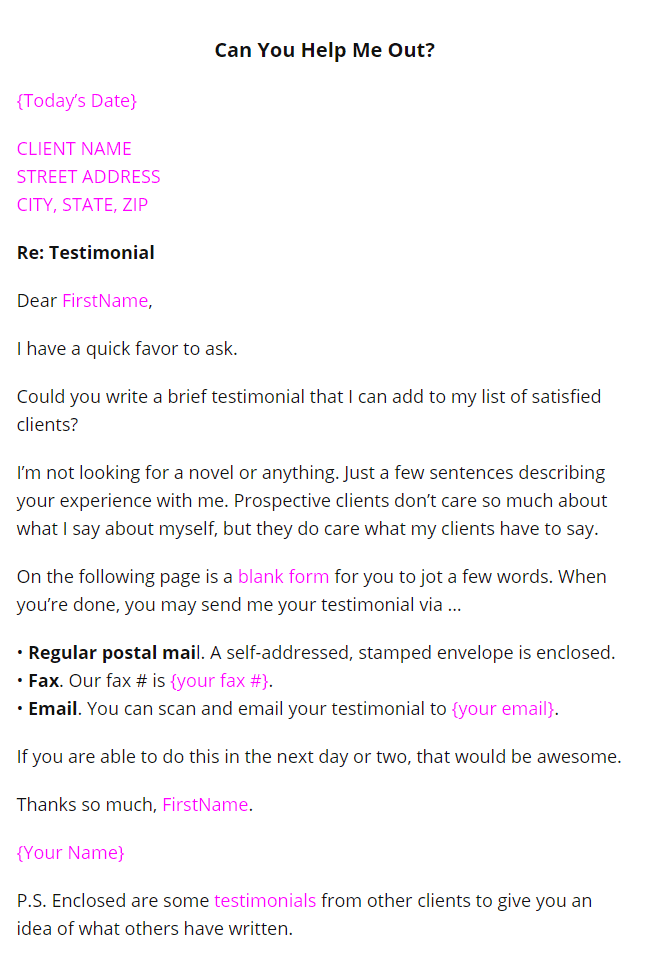3 Best Examples of Testimonial Request Letters That You Can Copy
Last edited: September 11th, 2024
Use Trustmary to collect customer testimonials effortlessly and efficiently.
Collect testimonials
Customer testimonials are essential for all businesses, as they play a significant role in driving sales.
Getting your happy customer to share their written or video testimonial is something that’s mostly not taken seriously enough – even though they’re essential for future business.
Sending testimonial request letters or emails to customers is one big challenge that businesses of all sizes face. How to make it persuasive enough to get people to respond?
That’s exactly what we’ll be tackling today. We’ll look at 3 templates for different needs, that you can copy or download, and implement right now (although some personalization tweaks are encouraged).
After reading this article, you’ll be able to:
- Draft the perfect email template for your needs.
- Get more testimonials from your happy customers.
- Boost your sales and marketing with great customer testimonials.
3 Best Examples of Testimonial Request Letters That You Can Copy
Customers, no matter how delighted they’re with your product, will rarely leave a positive review by themselves, let alone a high-quality written or video testimonial.
The probability of customers sharing customer testimonials proactively is low, so the obvious thing to do is to ask for a testimonial and expand your customer relationship. This will help you reach potential customers with more ease.
You have to actively gather testimonials!
Send your customers surveys via emails that simultaneously:
- Measure customer satisfaction
- Get open feedback
- Turn feedback into testimonials

Below are some of the best examples of testimonial letter emails that you can send to your customers.
Take ideas from these customer testimonial request emails and testimonial templates. You can then come up with your own customized template and simply ask for a testimonial.
1. Formal Email Request for B2B Customer

This is a formal example that works for a wide range of businesses and you can use it as a testimonial request email template.
Even though it’s usually best to keep the request short and sweet, sometimes you need a longer and more formal version. This is suitable for B2B clients, especially when the person you are contacting is highly authoritative.
The template can easily be personalized to each customer automatically, thanks to the use of merge fields. Just make sure you have all the data connected to the program you use for sending these email requests.
An automated email approach is open at this point, which will speed up getting client testimonials and patient testimonials.

Checklist for formal testimonial request template
There are a few things that you need to ensure your formal testimonial request letter has.
1. Refer to the milestone in the testimonial letter
The customer should have achieved a milestone with your product or collaboration. It could be anything ranging from completing a year, a reorder, an upgrade, a finished project, etc.
2. Get the timing right
The request for a testimonial email should be sent immediately after the milestone is completed. If delayed, it won’t be replied to. Customers tend to forget quickly so a delayed request won’t result in a genuine review.
Additionally, when you ask for a testimonial directly after a positive milestone, you are more likely to gain testimonials loaded with positive energy. It’s no coincidence that a weight loss app asks for feedback right after the user logs weight loss progress, or that a dating app asks for feedback after the user gets a match. It’s all about the peak moments, and you should leverage them, too.
It’s a good idea to use automation to do this. You can even integrate testimonial collection directly into your CRM to get the timing 100% on point each time.

3. Provide example customer testimonials
Share a link to the testimonial page with the customer where the review will be published. This testimonial request email template doesn’t share a link, but you should use one to show your customers how they’ll be used and to get inspired by existing testimonials.
4. Let them choose the format
Let the customer submit any review type based on their preference. Don’t restrict them to a specific review format. Give them the option to submit a text or video testimonials. If it fits your business, you can even add the option to add photos and product videos!
Tools like Trustmary enable you to collect text and video testimonials through one easy form.
5. What’s in it for them?
You can choose to use incentives, such as, discount codes, tokens, free training, free lunch… However, when using these email templates, incentives aren’t necessary.
Customers who have been with your business for some time and are satisfied, are the least interested in an incentive. Sending an incentive won’t persuade your customers to leave a review – good overall customer experience will.
They are happy to provide a favor for you if you have been able to ease their life and provide excellent service.
2. Postal Mail Request

Not all customers are email-friendly. Even in today’s time, a lot of people still prefer postal mail and it isn’t a smart move to ignore these customers.
Contacting customers for testimonials only through email can be a mistake.
You can also send a testimonial request through postal mail as well. The template above is a perfect example of a testimonial letter for postal mail.
Testimonial Requests through Post:
- A cover letter
- Testimonial letter (or form) that the customer needs to fill
- A sample testimonials (not necessary though)
- A stamped envelope
Again, you can’t send this request letter to any customer rather define a criterion and send it to customers who have achieved success with your product.
Refer to the milestone they have achieved with your product and ask them to fill the testimonial form.
Make sure you don’t add URLs in the letter because you’re contacting customers who are not computer-friendly so adding URLs will make them feel uncomfortable.
You don’t have to send them an incentive necessarily. However, a self-addressed stamped envelope is a must so they can send the filled testimonial form back without spending any money.
The testimonial form should include all the questions that the customer needs to answer so add a few words related to that.
- Use a Likert scale questionnaire.
- Add a feedback or comment section so customers can share their views about your product or their experience that you somehow forgot to include in the form.
3. Service Industry Request
The best time to get a review of a product is a few weeks after a sale.
If you’re interested in getting reviews on the customer experience and sales process, send a testimonial request directly after someone has purchased a product. You can even ask for feedback after each meeting, if you like.
This example of a testimonial request email works best for businesses in the service industry. Send it to your loyal customers when you have finished their project. This is the perfect time to get feedback on the deliverables.

Note that you can use this template for both physical products as well as services that you offered to a client.
When using Trustmary, you can request text and video testimonials with the same template. The below image illustrates how your customer can first draft a text testimonial, and then use it as a basis for their video testimonial.

4 Things to Include in Your Testimonial Request:
- Refer to the sales or project. Share its details in the email. Otherwise, the customer won’t know what they should talk about in their testimonial.
- Send an email after 1-2 days of the sale for first impressions. Don’t send it immediately. If you’re sending it to a client, ensure that you have sent your email after a reasonable time. Give your client due time to review your project before appearing in the customer’s inbox to request testimonials.
- The testimonial form should be relevant to the product (project) and the sales process. Don’t keep it general. It isn’t a good idea to ask questions related to the benefits that a customer gets from your product right after the sale and you’ll get quality testimonials.
- Give customers the option to submit a review in a format they’re comfortable with. Don’t restrict them. With Trustmary, you can include a text and video testimonial request in the same form.
Note that questions for video testimonials are a bit different from written testimonial questions.
An Easy Way to Every Customer Testimonial
Getting people to leave an honest review isn’t easy. You have to send them the right testimonial request emails at the optimal time via the right channel without being pushy when requesting testimonials.
So there is a couple of options you could go for when you ask for customer testimonials and impact the decision the customer makes:
- You could sign up for our software that is specifically designed for getting customer feedback and testimonials.
- Or you could just start testing different templates on your own. Tweak sentences describing what you need to improve the open and response rates. You’ll get better with time as you’ll test different variables of testimonials requests and learning from your previous post.
The examples covered in this post are for idea generation only so don’t use them directly to ask for testimonials. You don’t have to use these templates exactly what they are. Using the same thing over and over again can kill email conversations which you don’t want to do when you request a testimonial.
Regardless if you are using email automation to go through your clients’ contact information or you are asking to provide feedback manually, getting a good testimonial and adding it to your landing page achieved fantastic results for many businesses!
In general, building a template and a process that works takes a lot of tweaking, so if you choose that road you should start now and you can become a customer service leader in no time and reach other clients!
On the other hand, you can also start using our software and just follow a process we have tested and tweaked for years.
Benefits of Having Testimonials
Okay, before we dive deep into how to get testimonials from customers, let’s recap on why everyone should have testimonials and reviews on their website.
- Increase trust in your brand
- Get more contact requests (as much as 60%)
- 37% boost in sales (applies even to SaaS businesses)
Most potential customers look for reviews and testimonials from previous customers before making a purchase decision. If you fail to provide them, they might go look for a competing business that has public comments from happy customers.

5 Different Tools for Requesting Testimonials (+ Their Strengths & Weaknesses)
This section will briefly introduce the 5 different testimonial tools to use in 2024 and list the strengths and weaknesses of each.
1. Trustmary – Testimonial and Review Software
After having produced over 5,000 high-quality customer video testimonials, Trustmary developed software that is designed to gather and share social proof in written and video formats.
Furthermore, these testimonials can then be embedded wherever you wish and tracked with the same software.
This is the most efficient choice if you have many customers and want to get testimonials continuously. It saves you time and manual work.

Strengths:
- Easy to request testimonials from all customers with one survey
- Extensive selection of ready-made and tested survey and review templates
- You can gather an unlimited number of both written and video testimonials
- On average, 20% of satisfied customer leave a review
- Can be natively integrated with your CRM (HubSpot, Pipedrive, …)
- All your existing testimonials from other services can be imported
- Free options available
If you want to create review campaigns to get more organic reviews to Google, for example, you can create a campaign for free!
Start by typing your Google my Business location below (don’t worry, we won’t gain access to your account)
Weaknesses:
- The product is constantly being improved, so you need to get used to new features popping up
- If you have many customer touchpoints, you might need assistance in implementing the system to all of them. Luckily, we have a great customer success team to help you!
2. Email
If you don’t want to adopt a new software tool, you can send all your customers email by hand and ask for testimonials.
Strengths:
- No sign-ups needed
- Fast to send one
- Making a personal testimonial request can possibly increase the probability of answering
Weaknesses:
- Really time-consuming to send to all customers
- A lot of back-and-forth messaging is often needed
- Spam issues can occur if you send mass emails
- Not easy nor intuitive to respond to
3. Phone call
When was the last time you received an actual call from a business and they weren’t trying to sell you anything? Calling your customers to ask for testimonials will definitely make you memorable.
Strengths:
- Personal and probably very memorable
- Offers you insights on how your customers feel about you (if they have the time to talk with you)
Weaknesses:
- Very time-consuming for both you and your customers
- It’s best to have your testimonials in digital form so you can use them online
- Might be annoying for customers if they’re busy when you call
4. Mail
Not all of us are tech savvy. It might be that some of your customers don’t have access to email. Remember the include a response envelope that already has a stamp on it!
Strengths:
- Reach customer groups that don’t use email or whose email address you don’t have
- Personal touch
Weaknesses:
- Very pricy, due to all the manual labor and postal charges
- Risky, because the costs are so high and you can’t predict if anyone will answer
- If you get responses, you need to spend time making them online testimonials
5. Text message
Text messages are a very convenient way to ask for testimonials. They should be sent right after a purchase or visit to be relevant for the respondent.
Strengths:
- Fast to reply to
- Will offer a lot of quantitative data
- Sending can be automated to take place directly after a triggering event
Weaknesses:
- People often don’t provide open feedback via text messages
- Some won’t answer due to text message prices
Conclusion: Ask For Testimonials!
The key takeaway from this article is that you must ask for testimonials if you intend to receive them. To gather positive testimonials, start asking for them from your most loyal customers at the right points of the customer journey. You can ask your account manager for help with who to reach out to.
Don’t forget to tweak the testimonial request email templates before sending them to your clients. Feel free to personalize them and align them to your business so that you appear original when making testimonials requests.
There are various ways you can request testimonials and video testimonials, but the absolute best and most effective strategy is to use testimonial software like Trustmary.
It enables you to collect testimonials with minimum effort and keep them continuously flowing in.
You start a free 14-day trial and see how it works for you!
Further Reading
In case you’d like to dig deeper into the world of testimonials, we recommend reading the following articles others have found useful:
